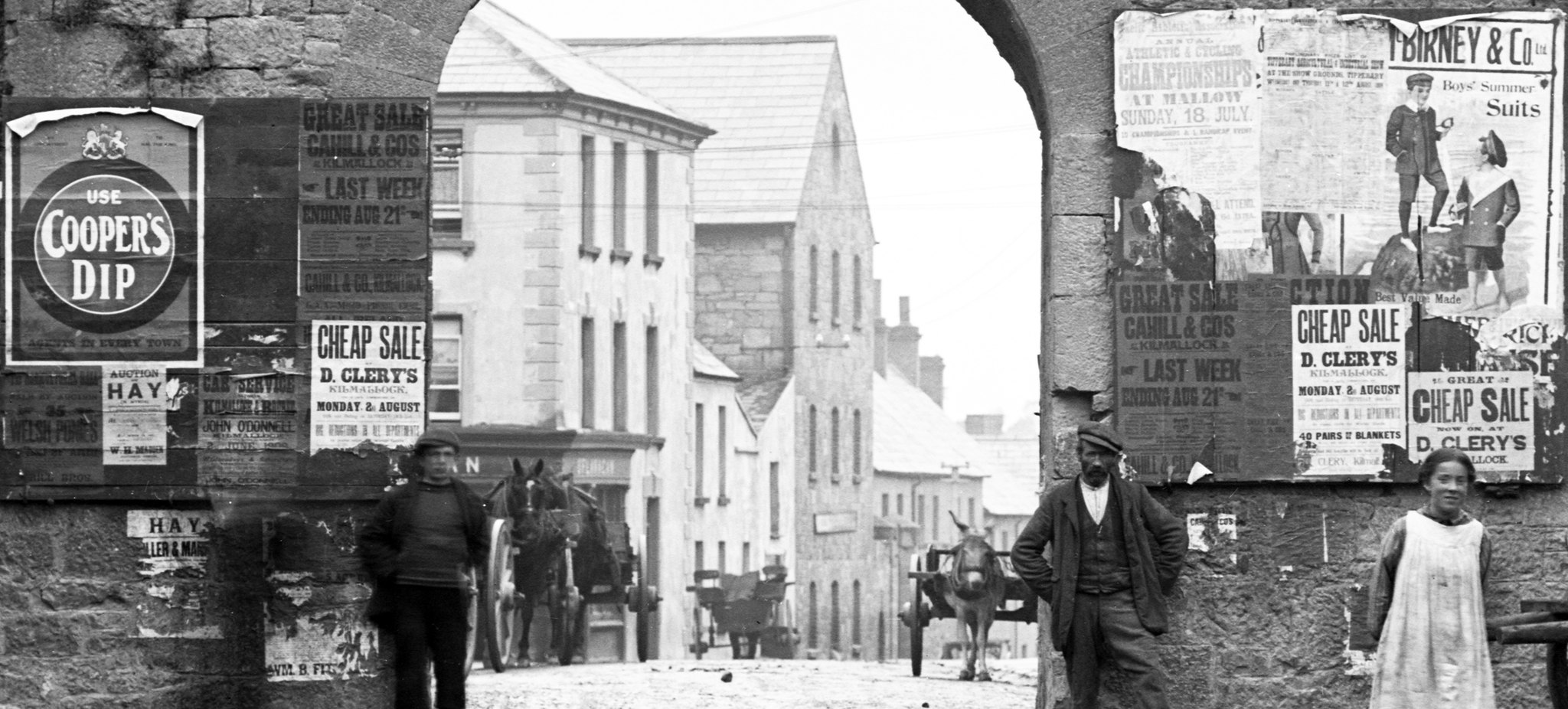
Blossom Gate, Kilmallock, County Limerick: photographer unknown, July 1909 (National Library of Ireland)
A New Song on the Taxes
All you young men and maidens come and listen to my song,
It is something short and comical, it won't detain you long.
Go where you will by day or night, the town or country through,
The people cry and wonder what with us they mean to do.
(Chorus)
No wonder people grumble at the taxes more and more,
There never was such taxes in Ireland before.
They're going to tax the farmers, and their horses, carts and ploughs,
They're going to tax the billygoats, the donkeys and the cows;
They're going to tax the mutton, and they're going to tax the beef,
And they're going to tax the women if they do not learn to read.
They will tax the ladies' chignons and their boas, veils and mats,
They're going to tax the mouse traps and the mousies, cats and rats;
They'll tax the ladies' flouncey gowns, their high-heeled boots and stays,
And before the sun begins to shine they'll tax the bugs and fleas.
They're going to tax the brandy, ale and whiskey, rum and wine,
They're going to tax all bachelors as heavy as they can,
They're going to tax the crutches and they'll tax the wooden legs,
They'll tax the ladies all that paint and those that walk with men,
They're going to tax the corn fields, potato gardens too,
A New Song On The Taxes: anon., n.d., from Irish Street Ballads, ed. Colm Ó Lochlainn, Printed and Published at the Sign of the Three Candles in Fleet Street, Dublin, 1939

Blossom Gate, Kilmallock, County Limerick: photographer unknown, July 1909 (National Library of Ireland)
All you young men and maidens come and listen to my song,
It is something short and comical, it won't detain you long.
Go where you will by day or night, the town or country through,
The people cry and wonder what with us they mean to do.
(Chorus)
No wonder people grumble at the taxes more and more,
There never was such taxes in Ireland before.
They're going to tax the farmers, and their horses, carts and ploughs,
They're going to tax the billygoats, the donkeys and the cows;
They're going to tax the mutton, and they're going to tax the beef,
And they're going to tax the women if they do not learn to read.
They will tax the ladies' chignons and their boas, veils and mats,
They're going to tax the mouse traps and the mousies, cats and rats;
They'll tax the ladies' flouncey gowns, their high-heeled boots and stays,
And before the sun begins to shine they'll tax the bugs and fleas.
They're going to tax the brandy, ale and whiskey, rum and wine,
They'll tax the tea and sugar, the tobacco, snuff and pipes;
They're going to tax the fish that swim and all the birds that fly,
An' they're going to tax the women who go drinking on the sly.
They're going to tax all bachelors as heavy as they can,
And they'll double tax the maidens who are over forty-one;
They'll tax the ground we walk on and the clothes that keep us warm,
And they're going to tax the childer on the night before they're born.
They're going to tax the crutches and they'll tax the wooden legs,
They're going to tax the bacon, bread and butter, cheese and eggs;
They're going to tax old pensioners as heavy as they can,
And they'll double tax young girls that go looking for a man.
They'll tax the ladies all that paint and those that walk with men,
They're going to tax the ducks and geese, and turkeys, cocks and hens;
They're going to tax the farmers' boys that work along the ditches,
And they'll double tax old drunken wives that try to wear the beeches.
They're going to tax the corn fields, potato gardens too,
They're going to tax the cabbage plants, the jackdaws and the crows;
They'll double tax the hobble skirts and table up some laws,
But the devil says he'll tax them if he gets them in his claws.
A New Song On The Taxes: anon., n.d., from Irish Street Ballads, ed. Colm Ó Lochlainn, Printed and Published at the Sign of the Three Candles in Fleet Street, Dublin, 1939

Blossom Gate, Kilmallock, County Limerick: photographer unknown, July 1909 (National Library of Ireland)
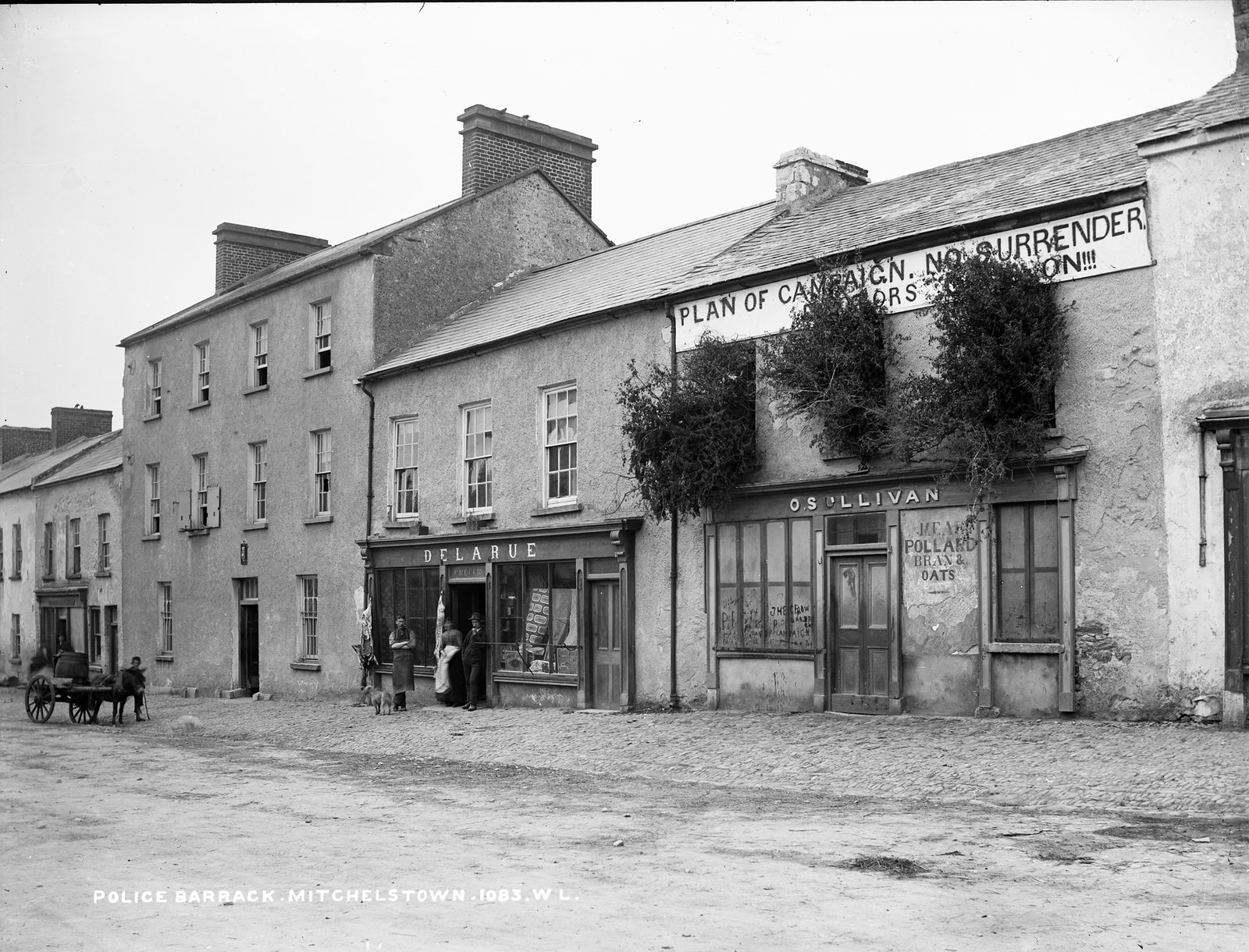
Mitchelstown
Eviction Resistance at O'Sullivan's, County Cork. The plan of the
campaign was an attempt to gain lower rents through collective bargaining because
prices on agricultural exports had fallen dramatically in the 1880s: photographer unknown, c. June 1887 (National Library of Ireland)
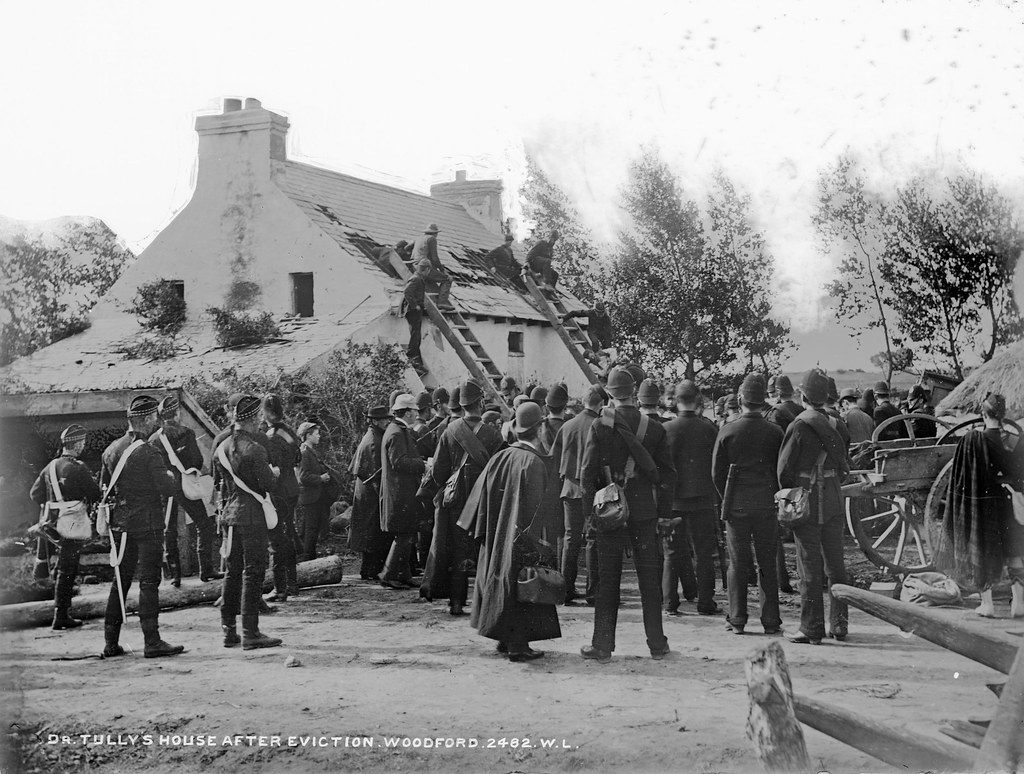
Dr
Tully's House. A eviction on land of the Marquis of Clanricarde at
Woodford, County Galway. Farmer and boat builder Francis Tully, known
locally as "Dr Tully", was an activist for the Plan of Campaign in Galway. The Plan of Campaign was an attempt
to gain lower rents through collective bargaining because
prices on agricultural exports had fallen dramatically in the 1880s.
Maud Gonne agitated for change by projecting images like this one onto
a building in Parnell Square, Dublin: photographer unknown, 1 September 1888 (National Library of Ireland)
Greece
may be financially bankrupt, but the troika is politically bankrupt.
Those who persecute this nation wield illegitimate, undemocratic powers,
powers of the kind now afflicting us all. Consider the International
Monetary Fund. The distribution of power here was perfectly stitched up:
IMF decisions require an 85% majority, and the US holds 17% of the
votes.
The IMF is controlled by the rich, and governs the poor on their behalf. It’s now doing to Greece what it has done to one poor nation after another, from Argentina to Zambia. Its structural adjustment programmes have forced scores of elected governments to dismantle public spending, destroying health, education and all the means by which the wretched of the earth might improve their lives.The same programme is imposed, regardless of circumstance: every country the IMF colonises must place the control of inflation ahead of other economic objectives; immediately remove barriers to trade and the flow of capital; liberalise its banking system; reduce government spending on everything bar debt repayments; and privatise assets that can be sold to foreign investors.
*
All this is but a recent chapter in the long tradition of subordinating human welfare to financial power. The brutal austerity imposed on Greece is mild compared with earlier versions. Take the 19th century Irish and Indian famines, both exacerbated (in the second case caused) by the doctrine of laissez-faire, which we now know as market fundamentalism or neoliberalism.
In Ireland’s case, one eighth of the population was killed –- one could almost say murdered -– in the late 1840s, partly by the British refusal to distribute food, to prohibit the export of grain or provide effective poor relief. Such policies offended the holy doctrine of laissez-faire economics that nothing should stay the market’s invisible hand.
The IMF is controlled by the rich, and governs the poor on their behalf. It’s now doing to Greece what it has done to one poor nation after another, from Argentina to Zambia. Its structural adjustment programmes have forced scores of elected governments to dismantle public spending, destroying health, education and all the means by which the wretched of the earth might improve their lives.The same programme is imposed, regardless of circumstance: every country the IMF colonises must place the control of inflation ahead of other economic objectives; immediately remove barriers to trade and the flow of capital; liberalise its banking system; reduce government spending on everything bar debt repayments; and privatise assets that can be sold to foreign investors.
*
All this is but a recent chapter in the long tradition of subordinating human welfare to financial power. The brutal austerity imposed on Greece is mild compared with earlier versions. Take the 19th century Irish and Indian famines, both exacerbated (in the second case caused) by the doctrine of laissez-faire, which we now know as market fundamentalism or neoliberalism.
In Ireland’s case, one eighth of the population was killed –- one could almost say murdered -– in the late 1840s, partly by the British refusal to distribute food, to prohibit the export of grain or provide effective poor relief. Such policies offended the holy doctrine of laissez-faire economics that nothing should stay the market’s invisible hand.
Greece is the latest battleground in the financial elite’s war on democracy (excerpts): George Monbiot, The Guardian,
7 July 2015 (updated 8 July 2015)
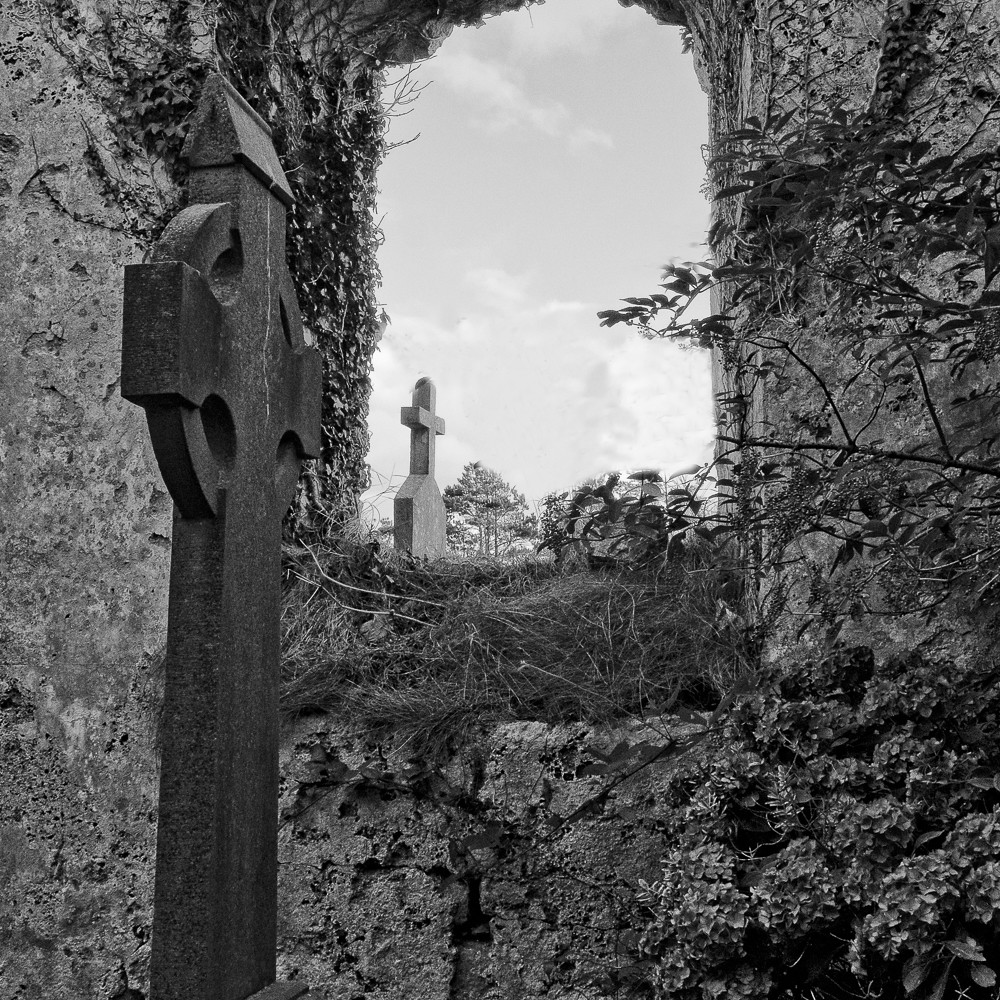
The Great Irish Famine. County Cork. The cemeteries are full of those who died of starvation in the Emerald Isle. Some call it genocide: photo by Elizabeth Haslam, 21 August 2014
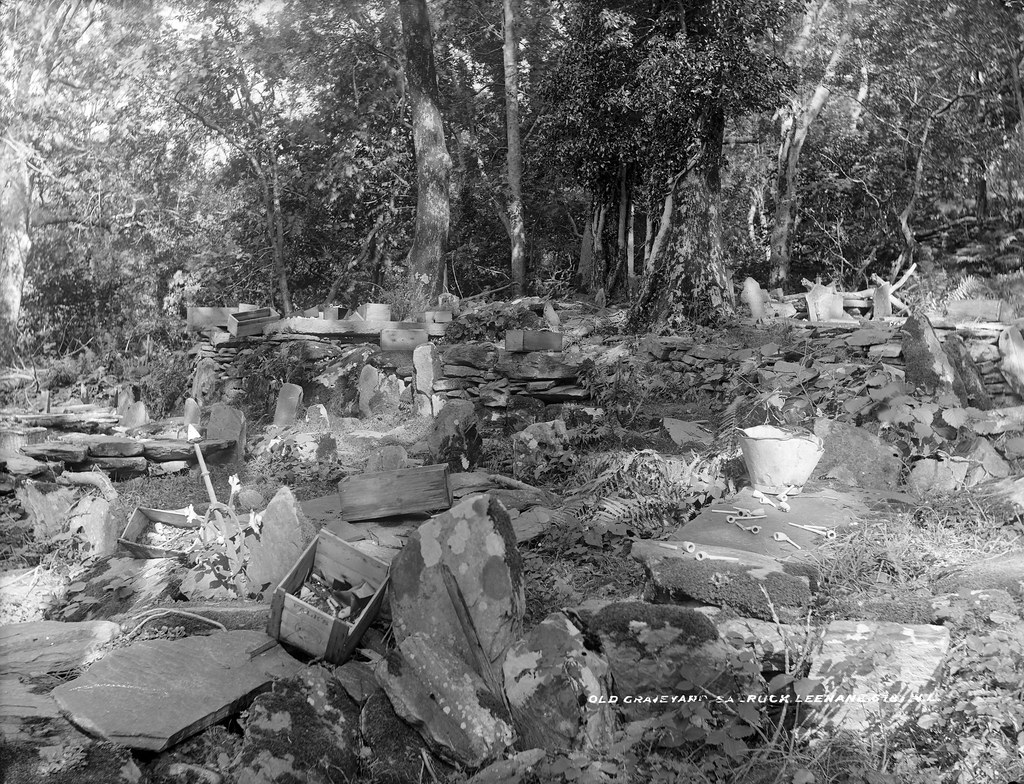
Old Graveyard. Salruck Graveyard at Leenane, County Galway, scattered with clay pipes or dúidín: photographer unknown, c. 1907 (National Library of Ireland)
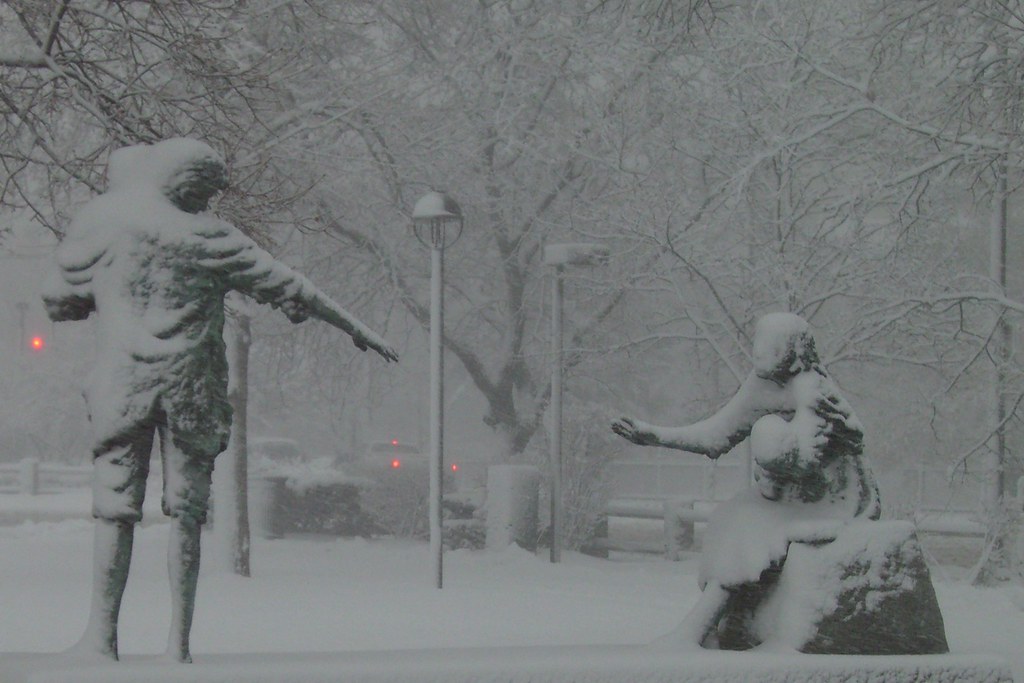
Irish Potato Famine memorial, Cambridge Commons, Cambridge, Massachusetts: photo by EandJsFilmCrew, 14 January 2009
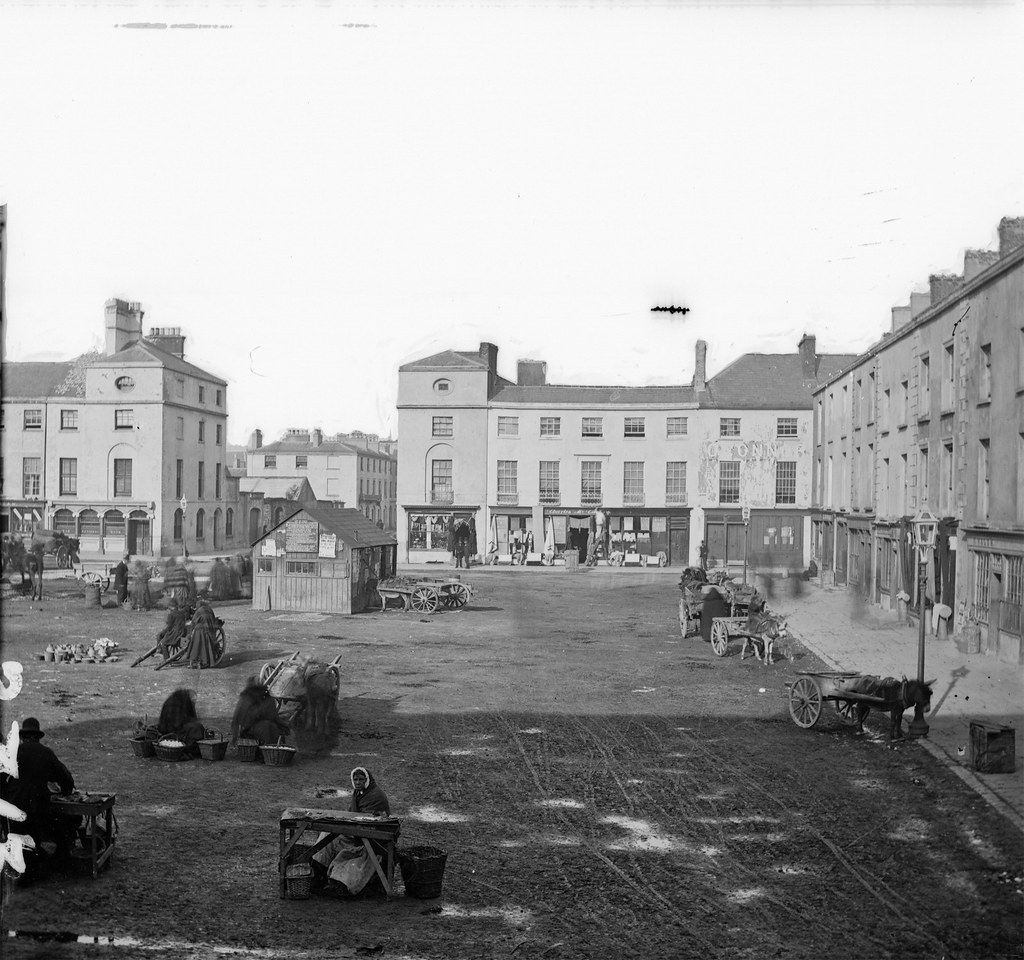
Market day, Grattan Square, Dungarvan, County Waterford: photographer unknown, c. 1870 (National Library of Ireland)
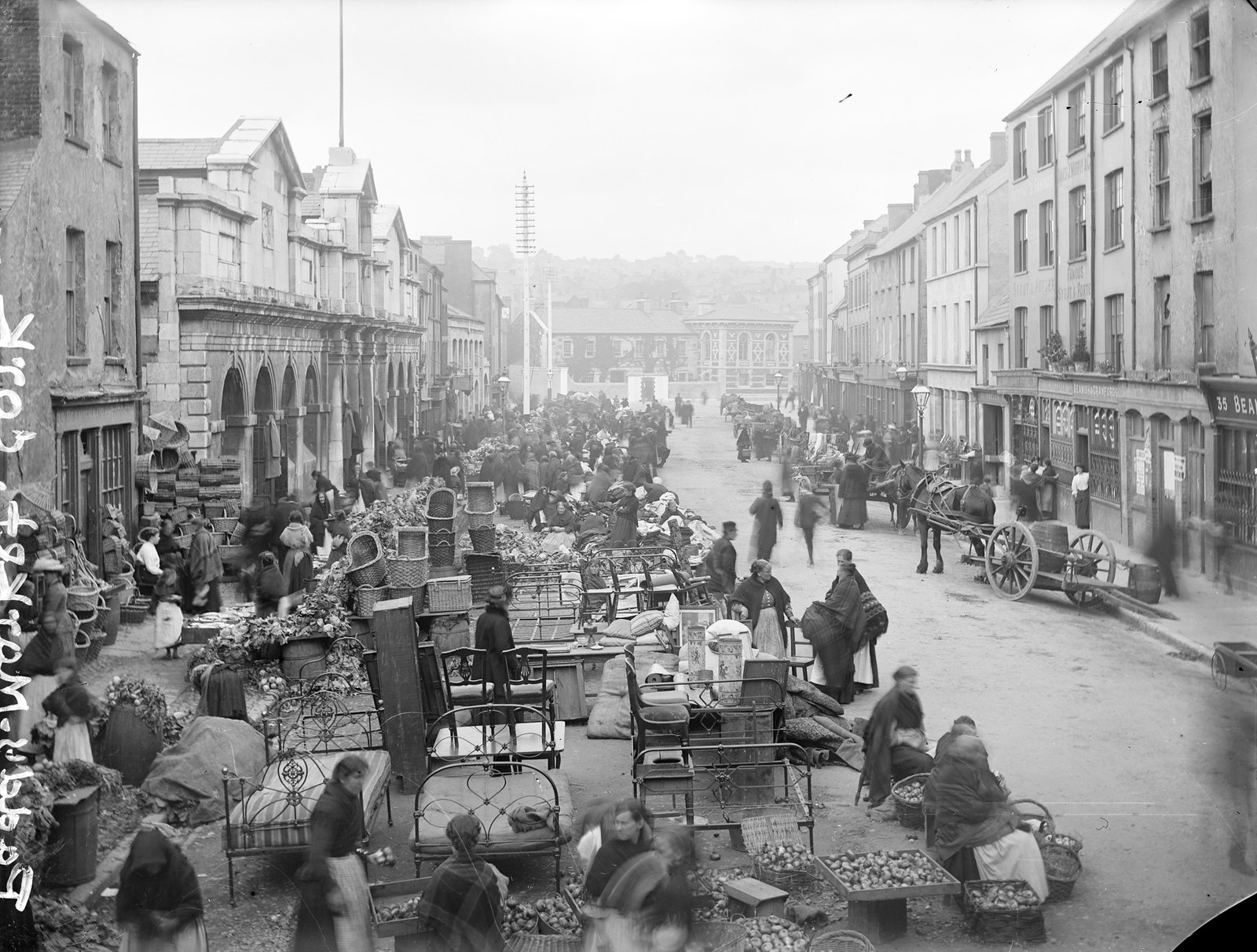
Paddy's Market, Cork City: photographer unknown, c. 1900 (National Library of Ireland)
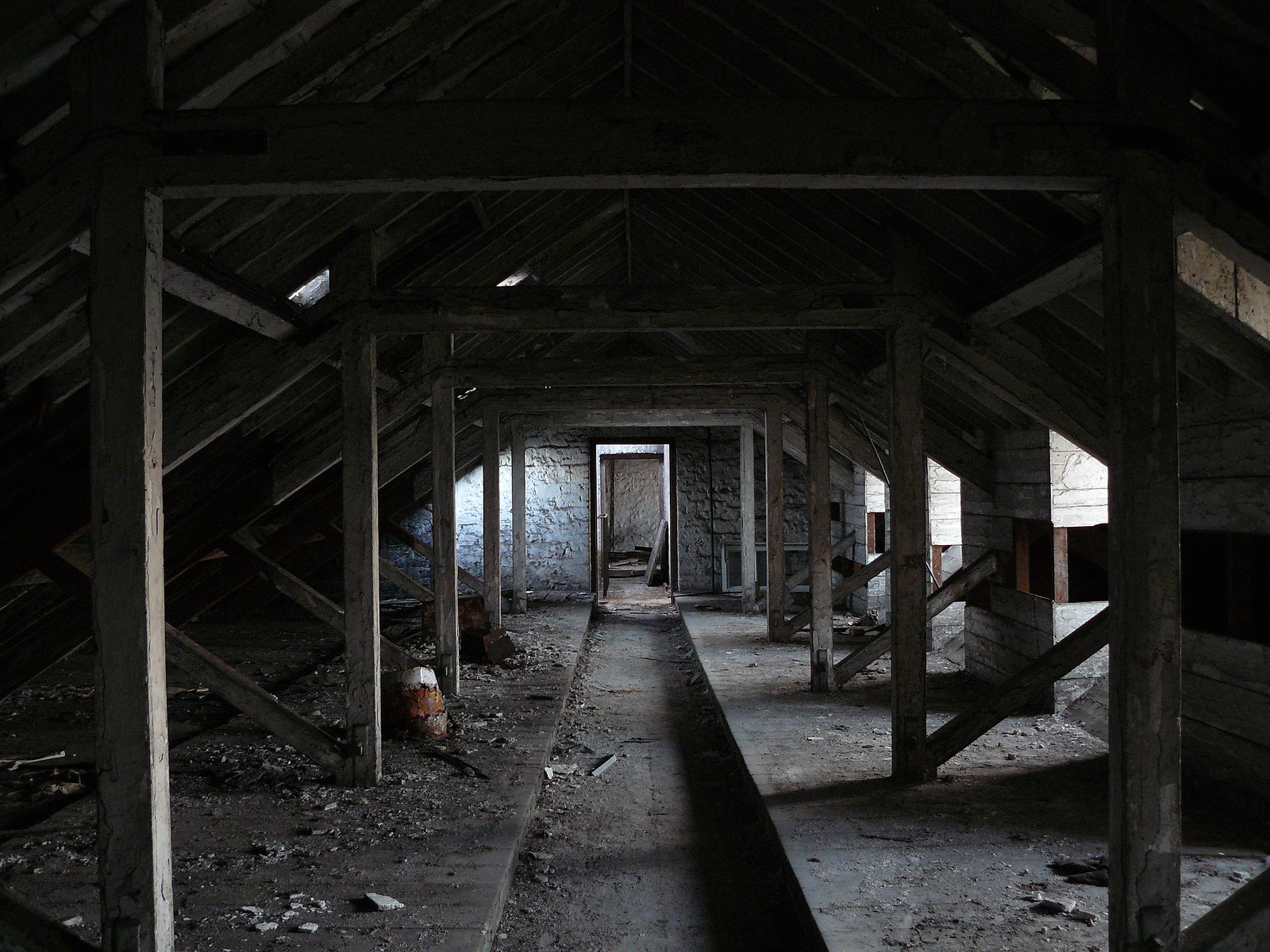
Boys' dormitory in an Irish workhouse. The workhouses in Ireland were built during the Great Famine in the 19th century to help deal with the poverty which arose as a result of the successive potato harvests. 165 of these huge complexes were built between 1841-1847 and designed to house 400-1000 destitute men, women and children. This particular workhouse was built to house 800 'paupers' however at the peak of the famine it housed over 3000. Many died from cholera and other diseases and were buried in mass graves at the end of the complex. On arrival families were separated into their respective gender and age category. This photo is one of the attic level dormitories for boys. An 'innovative' design feature were these raised sleeping platforms obliterating the need to provide individual beds. The children slept under straw with little else. Basically they froze during the winter and roasted during the summer. This one closed in 1921, many were demolished in an attempt to erase them from our collective memory and some remain as hospitals: photo by Dorman Architects, 8 May 2007

Monument to the Great Famine. Site of the Paupers' Grave, Kells Urban, County Meath. This cemetery was a necessity in the times of great poverty in this country. Mass is still celebrated there annually and the cemetery is a grim reminder of the Workhouse and the extreme poverty which was engendered by changes in farming practice in the 19th century, and also of the Famine: photo by John Brady, 27 March 2012

Market day, Grattan Square, Dungarvan, County Waterford: photographer unknown, c. 1870 (National Library of Ireland)

Paddy's Market, Cork City: photographer unknown, c. 1900 (National Library of Ireland)

Boys' dormitory in an Irish workhouse. The workhouses in Ireland were built during the Great Famine in the 19th century to help deal with the poverty which arose as a result of the successive potato harvests. 165 of these huge complexes were built between 1841-1847 and designed to house 400-1000 destitute men, women and children. This particular workhouse was built to house 800 'paupers' however at the peak of the famine it housed over 3000. Many died from cholera and other diseases and were buried in mass graves at the end of the complex. On arrival families were separated into their respective gender and age category. This photo is one of the attic level dormitories for boys. An 'innovative' design feature were these raised sleeping platforms obliterating the need to provide individual beds. The children slept under straw with little else. Basically they froze during the winter and roasted during the summer. This one closed in 1921, many were demolished in an attempt to erase them from our collective memory and some remain as hospitals: photo by Dorman Architects, 8 May 2007

Monument to the Great Famine. Site of the Paupers' Grave, Kells Urban, County Meath. This cemetery was a necessity in the times of great poverty in this country. Mass is still celebrated there annually and the cemetery is a grim reminder of the Workhouse and the extreme poverty which was engendered by changes in farming practice in the 19th century, and also of the Famine: photo by John Brady, 27 March 2012
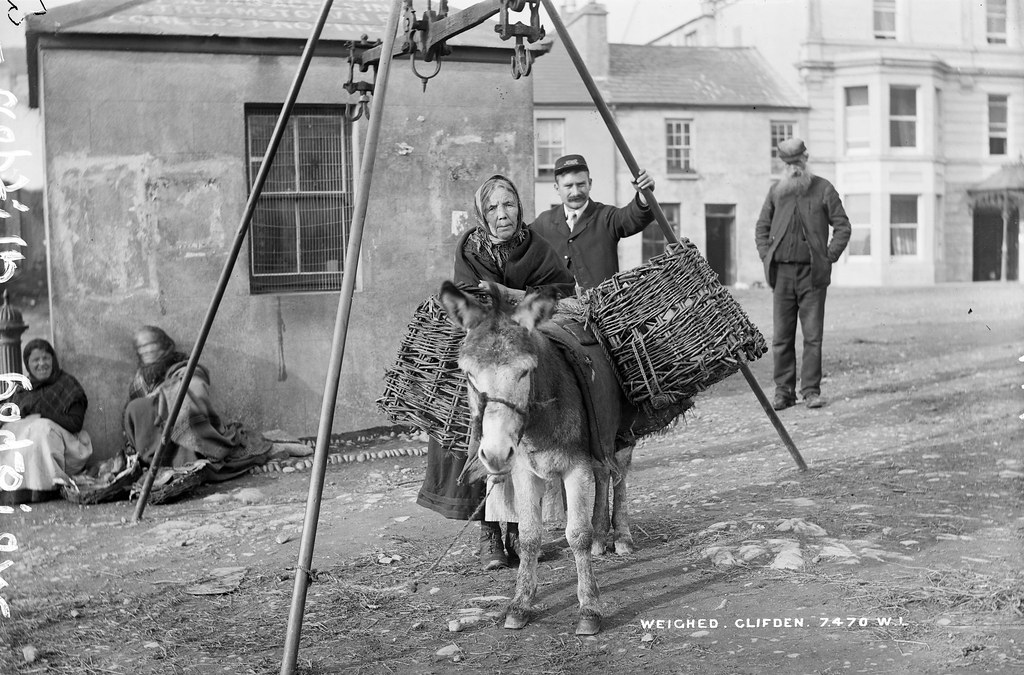
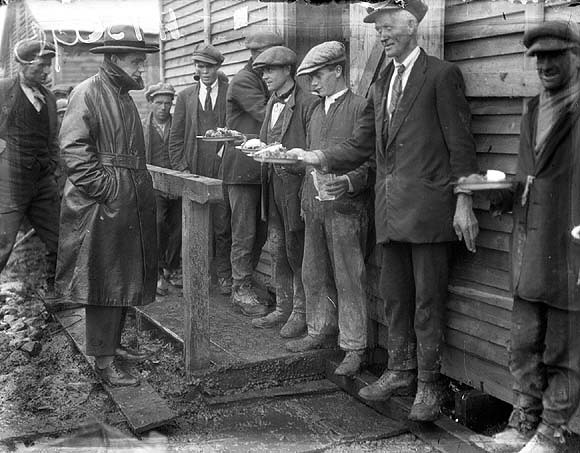
This post sets it out plain: that somehow free market economics (one could write a book on the use of the word free there) have nothing ideological about them is an old, old lie.
ReplyDeleteMonbiot on the nail again.
Yes, though everyone seems to remain frantic to believe it.
ReplyDeleteBy the by, Dunc, thought this on the Evictions (Dr Tully's House) might be of interest you:
ReplyDelete(Information courtesy of an insomniac reseacher, Jo Hedwig Teeuwisse, 2012)
"The only serious attempt at resisting the execution of the law was made by "Dr." Tully, one of the leading local "agitators," to the tendency of whose harangues judicial reference was made during the investigation into the case of Mr. Wilfrid Blunt. Tully had a holding of seventeen acres at a rent of L2, 10s., the Government valuation being L4. He earned a good livelihood as a boat-builder, and he had put up a slated house on his holding. But in November 1884 he chose to stop paying the very low rent at which he held his place, and he has paid no rent since that time. As is stated in a footnote on page 153, vol. ii. of this book, a decree was granted against Tully by Judge Henn for three years' rent due in May 1887, and his equity of redemption having expired July 9, 1888, this recourse was had to the law against him.
As the leading spirit of the agitation, Tully had put a garrison into his house of twelve men and two women. He had dug a ditch around it, taken out the window-sashes, filled up the casements and the doorways with stones and trunks of trees. Portholes had been pierced under the roof, through which the defenders might thrust red-hot pikes, pitchforks, and other weapons, and empty pails of boiling water upon the assailants. A brief parley took place. Tully refused to make any offer of a settlement unless the agent would agree to reinstate all the evicted tenants, to which Mr. Tener replied that he would recognise no "combination," but was ready to deal with every tenant fairly and individually. Finally the Sheriff ordered his men to take the place. Ladders were planted, and while some of the constables, under the protection of a shield covered with zinc, a sort of Roman _testudo_, worked at removing the earthern ramparts, others nimbly climbed to the roof and began to break in from above. In their excitement the garrison helped this forward by breaking holes through the roof themselves to get at the attacking party, and in about twenty minutes the fortress was captured, and the inmates were prisoners. Two constables were burned by the red-hot pikes, the gun of another was broken to pieces by a huge stone, and a fourth was slightly wounded by a fork. One of the defenders got a sword-cut; and Tully was brought forth as one too severely wounded to walk. Upon investigation, however, the surgeon refused to certify that he was unable to undergo the ordinary imprisonment in such cases made and provided.
The collapse of the resistance at this central point was followed by a general surrender.
After the capture of Tully's house, Mr. Tener writes to me, "I found it being gutted by his family, who would have carried it away piecemeal. They had already taken away the flooring of one of the rooms." Thereupon Mr. Tener had the house pulled down, with the result of seeing a statement made in a leading Nationalist paper that he was "evicting the tenants and pulling down their houses."
Ireland Under Coercion (2nd ed.) (2 of 2) (1888)
He wasn't really a doctor but was called this because he prescribed "leaden pills" (bullets) for greedy landlords...
[Jo Hedwig Teeuwisse continues:]
ReplyDeleteThis eviction was part of something called "the Woodford Evictions".
"Commons Debates - 15 April 1889
MR. JAMES STUART : I beg to ask the Chief Secretary to the Lord Lieutenant of Ireland whether Francis Tully, who was sentenced to two consecutive periods of six months each in connection with his defence of his house at the Woodford evictions in August, 1887, has now been over six mouths in gaol; whether it is the case that his eyesight is becoming impaired owing to his imprisonment; and, whether, inasmuch as the two sentences were practically for the same offence, he would consider the advisability of extending some clemency towards him?
*MR. A. J. BALFOUR : The Prisons Board informs me that the reply to the inquiry in the first paragraph is in the affirmative. The Medical Officer reports that the prisoner has lately had slight catarrhal ophthalmia, for which he is under treatment and improving daily, but that his general health could not be better. I am advised that the two sentences were not practically for the same offence."
But after having said all this, I'll have to admit that, notwithstanding Dr Tully, or perhaps in light of him, it has been discouraging to see the Irish, with the Germans of course pricking them on, falling into the EUrofraktur Abyss, on the side that a country with their history should be shamed by.
ReplyDeleteDunno, perhaps it's just the sight of that German flag
flying on the government building in Dublin.